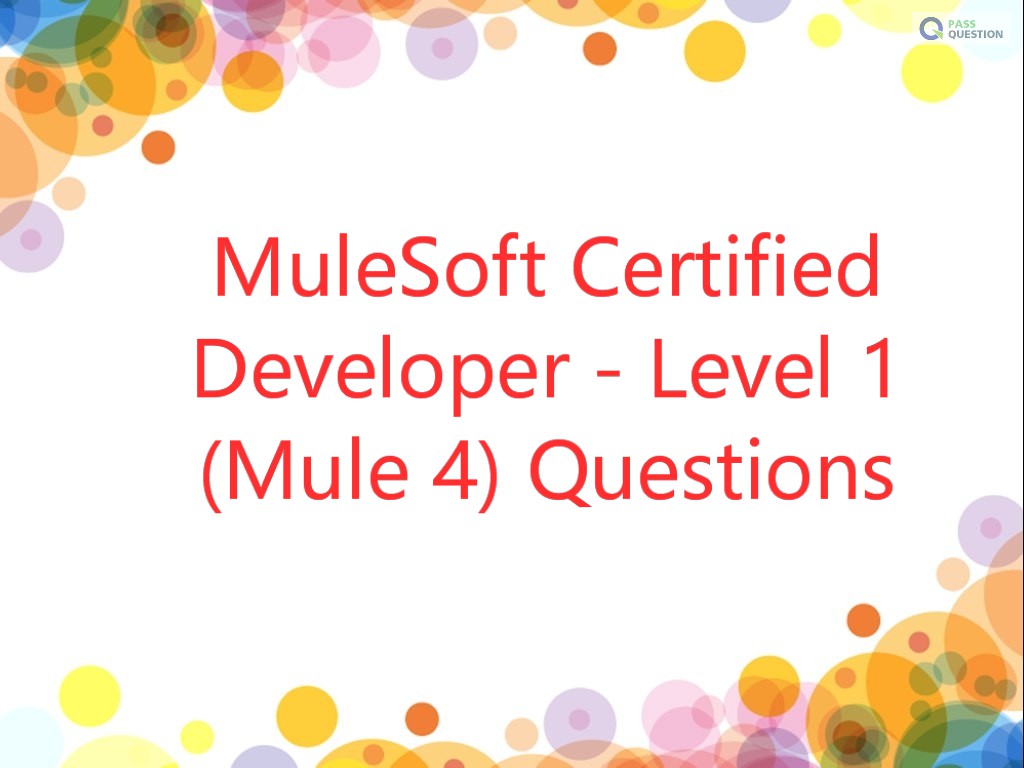MuleSoft Certified Developer - Level 1 (Mule 4) Questions
MuleSoft Certified Developer - Level 1 (Mule 4) exam is a MCD-Level 1 Certification test.PassQuestion provides MuleSoft Certified Developer - Level 1 (Mule 4) Questions that are not only going to help you prepare for MuleSoft Certified Developer MCD-Level-1 exam but will also ensure a high score.PassQuestion ensures you 100% pass your MuleSoft Certified Developer - Level 1 exam successfully.
What is MuleSoft Certified Developer - Level 1 (Mule 4) Exam?
A MuleSoft Certified Developer – Level 1 should be able to successfully work on basic Mule 4 projects with guidance and supervision. The MCD – Level 1 (Mule 4) exam validates that a developer has the required knowledge and skills to design, build, test and debug, deploy, and manage basic APIs and integrations: moving from Anypoint Platform to Anypoint Studio and back. S/he should be able to:
Use MuleSoft-hosted Anypoint Platform to take a basic API through all the steps of its lifecycle: design, build, deploy, manage, and govern.
Use Anypoint Studio to build, test, and debug basic integrations and API implementations.
Connect to a range of resources including databases, files, web services, SaaS applications, and JMS queues.
Perform basic data transformations using DataWeave 2.
Control event flow and handle errors.
Process batch records.
Exam Format
Format: Multiple-choice, closed book, proctored online or in a testing center
Length: 60 questions
Duration: 120 minutes (2 hours)
Pass score: 70%
Language: English
Cost: $250
The exam can be taken a maximum of 5 times, with a 24 hour wait between each attempt.
Exam Topics
Explaining Application Network Basics
Designing and Consuming APIs
Accessing and Modifying Mule Events
Structuring Mule Applications
Building API Implementation Interfaces
Routing Events
Handling Errors
Transforming Data with DataWeave
Using Connectors
Processing Records
Debugging and Troubleshooting Mule Applications
Deploying and Managing APIs and Integrations

View Online MuleSoft Certified Developer - Level 1 (Mule 4) Free Questions
1.How would you debug Mule applications?
A. Using breakpoints
B. Checking RAML
C. By Deploying apps on production
D. Cannot do it
Answer: A
2.What does to the attributes of a Mule event happen in a flow after an outbound HTTP Request is made?
A. Attributes do not change.
B. Previous attributes are passed unchanged.
C. Attributes are replaced with new attributes from the HTTP Request response.
D. New attributes may be added from the HTTP response headers, but no headers are ever removed.
Answer: C
3.The new RAML spec has been published to Anypoint Exchange with client credentials.
What is the next step to gain access to the API?
A. Email the owners of the API.
B. Create a new client application.
C. No additional steps needed.
D. Request access to the API in Anypoint Exchange.
Answer: D
4.What is the difference between a subflow and a sync flow?
A. Sync flow has no error handling of its own and subflow does.
B. Subflow has no error handling of its own and sync flow does.
C. Subflow is synchronous and sync flow is asynchronous.
D. No difference.
Answer: B
5.What is not an asset?
A. Exchange
B. Template
C. Example
D. Connector
Answer: A
6.How to import Core (dw::Core) module into your DataWeave scripts?
A. import dw::core
B. Not needed
C. None of these
D. import core
Answer: B
- TOP 50 Exam Questions
-
Exam
All copyrights reserved 2025 PassQuestion NETWORK CO.,LIMITED. All Rights Reserved.

